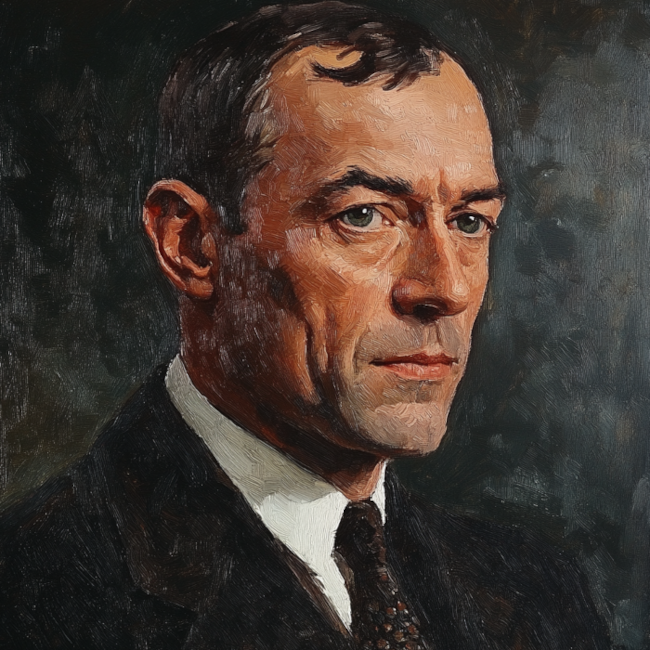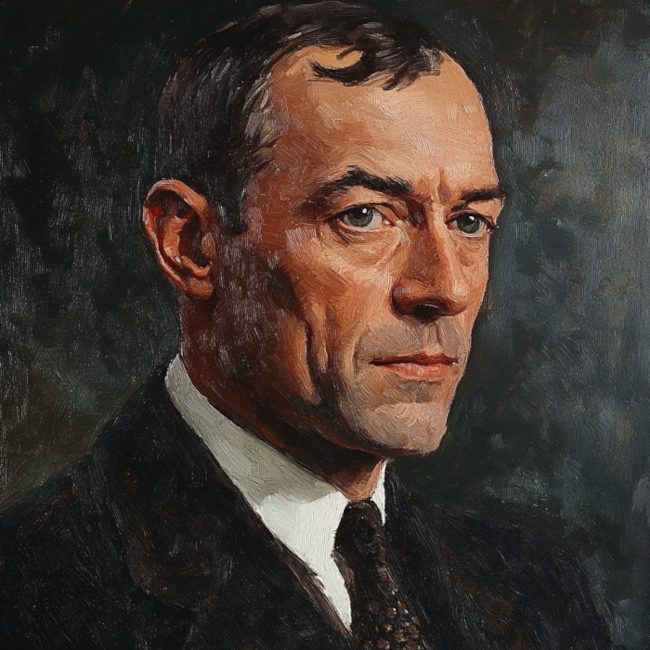


Sergei Vasilyevich Rachmaninoff (1873–1943) was a Russian composer, pianist, and conductor, widely regarded as one of the greatest pianists of his time and a key figure in late Romantic music. Known for his richly expressive compositions, Rachmaninoff's works are celebrated for their powerful melodies, emotional depth, and technical brilliance. His compositions include concertos, symphonies, piano solos, and choral works, and he is especially famous for his Piano Concertos and Prelude in C-sharp minor. Rachmaninoff's music blends influences from Russian folklore, Orthodox liturgy, and the Romantic tradition, making his style uniquely distinctive.
Birth and Family Background: Sergei Rachmaninoff was born on April 1, 1873, in Semyonovo, in the Novgorod Governorate of the Russian Empire. He came from a well-established aristocratic family with a strong musical tradition. His father, Vasily Arkadyevich Rachmaninoff, was a former army officer, and his mother, Lyubov Petrovna Butakova, was an amateur pianist. Due to his father’s poor financial management, the family lost much of their wealth and moved frequently during Rachmaninoff's childhood.
Early Musical Training: Rachmaninoff began piano lessons at the age of four, initially taught by his mother. Recognizing his talent, his family enrolled him at the Saint Petersburg Conservatory when he was nine. However, his early education was hindered by personal difficulties, including the death of his sister and financial issues within the family. In 1885, he transferred to the Moscow Conservatory, where he studied under Nikolai Zverev, a strict but influential teacher, and later received instruction from Sergei Taneyev and Anton Arensky.
Graduation and Early Works: Rachmaninoff graduated from the Moscow Conservatory in 1892, receiving the Great Gold Medal for his composition. During his time as a student, he composed several notable works, including the "Piano Concerto No. 1" (1891) and the famous "Prelude in C-sharp minor" (1892), which became one of his most recognizable pieces. His early works reflected the influence of Pyotr Ilyich Tchaikovsky, whom Rachmaninoff greatly admired.
Early Compositions and Breakthroughs: In the early 1890s, Rachmaninoff composed several orchestral and operatic works, including his "Symphony No. 1" (1895). Unfortunately, the premiere of the symphony in 1897 was a disaster, partly due to the poor conducting of Alexander Glazunov, who was allegedly intoxicated. The negative reception of the symphony was a severe blow to Rachmaninoff's confidence, and he fell into a deep depression that lasted several years, struggling with writer's block and self-doubt.
Hypnotherapy and Recovery: In 1900, Rachmaninoff sought help from Dr. Nikolai Dahl, a physician who used hypnotherapy to treat Rachmaninoff's depression. Dahl’s treatment proved successful, and Rachmaninoff began to compose again. This period led to the creation of one of his most famous works, the "Piano Concerto No. 2 in C minor, Op. 18" (1901), which became a resounding success and remains one of the most popular piano concertos in the classical repertoire. The concerto marked a triumphant comeback and reestablished Rachmaninoff’s confidence as a composer.
Piano Concerto No. 2 and Success as a Composer: The success of the "Piano Concerto No. 2" brought Rachmaninoff widespread acclaim as both a pianist and a composer. Over the next decade, he composed some of his most notable works, including "Sonata No. 2 for Piano" (1913), the "Variations on a Theme of Chopin" (1903), and the "Symphony No. 2 in E minor, Op. 27" (1907). His "Rhapsody on a Theme of Paganini, Op. 43" (1934), written for piano and orchestra, also became one of his most beloved pieces, especially the 18th variation, which is often regarded as one of the most beautiful romantic themes ever written.
Conductor and Pianist: Rachmaninoff was also active as a conductor, serving as conductor of the Bolshoi Theatre from 1904 to 1906. His conducting career allowed him to travel across Europe, building his reputation as a distinguished figure in Russian classical music. As a pianist, Rachmaninoff was widely regarded as one of the finest of his era, known for his precise technique, powerful tone, and deep musical expression.
Marriage: In 1902, Rachmaninoff married Natalya Satina, his first cousin, after receiving a special dispensation from the Russian Orthodox Church. Natalya provided him with emotional stability and support throughout his career, and their marriage was a happy one. They had two daughters, Irina and Tatiana.
Russian Revolution and Emigration (1917): The Russian Revolution of 1917 and the subsequent upheaval had a profound impact on Rachmaninoff. Faced with the instability and uncertainty of the new Soviet regime, he decided to leave Russia with his family. In December 1917, they fled to Scandinavia and eventually settled in the United States in 1918. Rachmaninoff would never return to his homeland, and his exile deeply affected him, with his music often reflecting a sense of nostalgia and loss for Russia.
Career in the United States: After emigrating, Rachmaninoff focused more on his career as a concert pianist to support his family financially, often at the expense of his compositional work. He embarked on grueling concert tours across North America and Europe, gaining fame as a virtuoso pianist and performing in some of the most prestigious venues. His concerts showcased his own works, as well as those of other composers, and were known for their technical brilliance and emotional depth.
Rhapsody on a Theme of Paganini (1934): In 1934, Rachmaninoff composed the "Rhapsody on a Theme of Paganini, Op. 43", which is based on Niccolò Paganini's 24th Caprice for solo violin. The piece, written for piano and orchestra, is structured as a set of 24 variations on Paganini's theme. The 18th variation is particularly famous for its lyrical beauty and has been featured in numerous films and popular culture.
Symphony No. 3 and Symphonic Dances: Despite his busy schedule as a performer, Rachmaninoff managed to continue composing. In 1936, he completed his "Symphony No. 3 in A minor, Op. 44", which was more introspective and showed a different, more modern aspect of his musical style. His final major work, the "Symphonic Dances, Op. 45", was composed in 1940. The Symphonic Dances are notable for their rhythmic energy, orchestral color, and the recurring Dies Irae theme, which Rachmaninoff used in several of his compositions. This piece stands as a fitting capstone to his career, showcasing his mastery of orchestration and his signature blend of melancholy and exuberance.
Late Romantic Style: Rachmaninoff’s music is characterized by its lush harmonies, sweeping melodies, and deep emotional expression. His compositional style remained firmly rooted in the late Romantic tradition, even as the musical world moved towards modernism. He drew inspiration from Tchaikovsky, Chopin, and Liszt, but his works also reflect a distinctly Russian character, influenced by folk music and Orthodox liturgical chants.
Technical Demands and Pianistic Brilliance: As a virtuoso pianist, Rachmaninoff composed works that often showcased his extraordinary technical abilities. His piano concertos and solo piano works are known for their demanding passages, requiring a high level of technical skill and emotional depth from the performer. Rachmaninoff's hands were famously large, allowing him to play wide intervals with ease, and his piano compositions often exploit the instrument’s full range.
Themes of Nostalgia and Melancholy: Rachmaninoff’s music often evokes a sense of nostalgia and melancholy, reflecting both his personal experiences of loss and his sense of dislocation after leaving Russia. His works are imbued with a sense of yearning, and many of his melodies are hauntingly beautiful, conveying both grandeur and introspection. His music remains beloved for its ability to evoke deep emotion and connect with listeners on a visceral level.
Declining Health and Final Performances: During his final years, Rachmaninoff's health began to decline. Despite his struggles, he continued to perform and record, completing his final tour in 1943. His final concert took place in Knoxville, Tennessee, in February 1943, during which he played pieces by Chopin and Beethoven along with his own works. By this time, his health had deteriorated significantly due to melanoma, and he struggled to continue performing.
Death: Sergei Rachmaninoff passed away on March 28, 1943, just a few days before his 70th birthday, at his home in Beverly Hills, California. He was buried in Kensico Cemetery in Valhalla, New York. His death marked the end of an era in classical music, as Rachmaninoff was one of the last great representatives of the Romantic tradition in a world increasingly moving towards modernism.
Influence on Later Composers and Performers: Sergei Rachmaninoff’s legacy as a composer, pianist, and conductor is profound. His works continue to be a staple of the classical repertoire, especially his piano concertos, Preludes, and Rhapsody on a Theme of Paganini. He is remembered as one of the greatest pianists of his time, and his influence can be seen in the playing styles of later pianists such as Vladimir Horowitz, Sviatoslav Richter, and Van Cliburn. His approach to melody, harmony, and form has also influenced many composers who came after him, and his music remains deeply cherished for its emotional power.
Enduring Popularity: Despite the shifting musical landscape of the 20th century, Rachmaninoff’s works have remained enduringly popular. His music, with its heartfelt melodies and expressive depth, resonates with audiences around the world. Pieces like "Piano Concerto No. 2", "Rhapsody on a Theme of Paganini", and "Vocalise" are frequently performed by leading orchestras and soloists, and they continue to captivate listeners with their emotional immediacy and technical brilliance.
Critics and Supporters: Rachmaninoff’s music was often criticized during his lifetime by those who favored more avant-garde developments in music, such as the atonal works of Arnold Schoenberg or the experimentalism of Igor Stravinsky. However, Rachmaninoff remained true to his own artistic vision, prioritizing melody, emotion, and the Romantic tradition. Today, his works are celebrated for their beauty and emotional impact, and he is recognized as one of the most important composers of his era.
Recordings and Piano Rolls: Rachmaninoff made a number of recordings of his own works, as well as works by other composers, which are highly regarded for their artistry and serve as a valuable document of his style as a pianist. He also recorded player piano rolls, which capture his performances with remarkable fidelity. These recordings have played an important role in preserving his interpretations for future generations of pianists and music lovers.
Sergei Rachmaninoff was a towering figure in 20th-century classical music, whose compositions, piano performances, and conducting left an indelible mark on the world of music. As one of the last great composers of the Romantic tradition, Rachmaninoff's works are celebrated for their emotional depth, technical brilliance, and expressive beauty. His piano concertos, symphonies, and solo piano works continue to be beloved by musicians and audiences alike, standing as a testament to his enduring legacy.
Rachmaninoff's life was marked by both triumphs and challenges, including his early struggles with depression and his forced exile from Russia. Despite these difficulties, he remained true to his artistic vision, creating music that spoke directly to the human experience. His compositions continue to evoke a deep sense of nostalgia, longing, and passion, and they have ensured his place as one of the greatest composers and pianists of all time.

We use cookies
We use cookies and other tracking technologies to improve your browsing experience on our website, to show you personalized content and targeted ads, to analyze our website traffic, and to understand where our visitors are coming from. Privacy Policy.